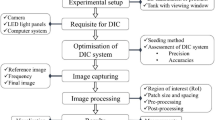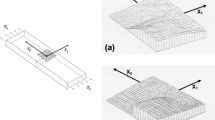Abstract
This paper is the outcome of a specific task group of the RILEM Technical Committee 241-MCD “Mechanisms of Cracking and Debonding in Asphalt and Composite Pavements”. The group on “Advanced Measurement Techniques” was established in 2011 to investigate DIC applications for non-destructive and non-contact measurements of strain fields during laboratory testing. The paper illustrates different DIC/optical flow applications in measuring strain distribution during laboratory testing. Specific applications of DIC for evaluating crack initiation and crack propagation in asphalt materials are presented.


















Similar content being viewed by others
References
Birgisson B, Montepara A, Romeo E, Roque R, Roncella R, Tebaldi G (2007) Determination of fundamental tensile failure limits of mixtures. J Assoc Asph Paving Technol 76:303–344
Birgisson B, Montepara A, Romeo E, Roque R, Roncella R, Tebaldi G (2009) An optical strain measurement system for asphalt mixtures. Mater Struct 42(4):427–441. doi:10.1617/s11527-008-9392-8
Birgisson B, Montepara A, Romeo E, Roque R, Tebaldi G (2010) Influence of mixture properties on fracture mechanics in asphalt mixtures. Road Mater Pavement Des 11:68–88. doi:10.3166/rmpd.11hs.61-88
Chehab GR, Kim YR, Schapery R, Witzack M, Bonaquist R (2003) Characterization of asphalt concrete in tension using a viscoelastoplastic model. J Assoc Asph Paving Technol 72:315–355
Chehab GR, Seo Y, Kim YR (2007) Viscoelastoplastic Damage Characterization of Asphalt-Aggregate Mixtures using Digital Image Correlation. Int J Geomech 7(2):111–118. doi:10.1061/(ASCE)1532-3641(2007)7:2(111)
Correlated Solutions http://www.correlatedsolutions.com/vic-2d/. Accessed 25 July 2013
Dave EV, Braham AF et al (2008) Integration of laboratory testing, field performance data and numerical simulations for the study of low-temperature cracking. In: Al-Qadi L, Scarpas T, Loizos A (eds) Proceedings of the 6th RILEM International Conference on Cracking in Pavements, Chicago. CRC Press; Taylor and Francis Group, New York, pp 369–378
Dave EV, Ahmed S, Buttlar WG, Bausano JP, Lynn T (2010) Investigation of strain tolerant mixture reflective crack relief systems: an integrated approach. J Assoc Asphalt Paving Technol 79:119–156
Diakhate M, Phelipot A, Millien A, Petit C (2006) Shear fatigue behaviour of tack coats in pavement. J Road Mater Pavement Des 7(2):201–222
Hartman AM, Gilchrist MD (2004) Evaluating four-point bend fatigue of asphalt mix using image analysis. J Mater Civ Eng 16(1):60–68. doi:10.1061/(ASCE)0899-1561(2004)16:1(60)
Im S, Kim YR, Ban H (2013) Rate- and temperature-dependent fracture characteristics of asphaltic paving mixtures. ASTM J Test Eval 41(2):1–12. doi:10.1520/JTE20120174
Kim YR, Little DN (1990) One-dimensional constitutive modeling of asphalt concrete. J Eng Mech 116(4):751–772. doi:10.1061/(ASCE)0733-9399(1990)116:4(751))
Kim YR, Wen H (2002) Fracture Energy from Indirect Tension Test. J Assoc Asph Paving Technol 71:779–793
Lecompte D, Smits A, Bossuyt S, Sol H, Vantomme J, Van Hemelkijck D, Habraken AM (2006) Quality assessment of speckle patterns for digital image correlation. Opt Lasers Eng 44(11):1132–1145. doi:10.1016/j.optlaseng.2005.10.004
Marasteanu M et al (2012) Investigation of low temperature cracking in asphalt pavements national pooled fund study—phase II, Report No. MN/RC 2012-23, Minnesota Department of Transportation, St. Paul, MN
Masad E, Muhunthan B, Shashidhar N, Harman T (1998) Aggregate orientation and segregation in asphalt concrete. In: Proceedings of sessions of geo-congress on application of geotechnical principles in pavement engineering, pp 69–80
Masad E, Muhunthan B, Shashidhar N, Harman T (1999) Internal structure characterization of asphalt concrete using image analysis. J Comput Civ Eng 13(2):88–95. doi:10.1061/(ASCE)0887-3801(1999)13:2(88)
Masad E, Somadevan N, Bahia HU, Kose S (2001) Modeling and experimental measurements of strain distribution in asphalt mixes. J Transp Eng 127(6):477–485. doi:10.1061/(ASCE)0733-947X(2001)127:6(477)
Montepara A, Romeo E, Birgisson B, Tebaldi G (2010) Strain localization and damage distribution in SBS polymer modified asphalt mixtures. Road Mater Pavement Des 11(4):899–915. doi:10.3166/rmpd.11.899-915
Romanoschi SA, Metcalf JB (2001) The characterization of asphalt concrete layer interfaces. 80th Annual TRB Meeting. Transportation Research Board, Washington, DC
Romeo E (2013) Two-dimensional digital image correlation for asphalt mixture characterisation: interest and limitations. Road Mater Pavement Des. doi:10.1080/14680629.2013.815128
Roque R, Birgisson B, Sangpetgnam B, Zhang Z (2002) Hot mix asphalt fracture mechanics: a fundamental crack growth law for asphalt mixtures. J Assoc Asph Paving Technol 71:816–827
Schreier HW (2003) Investigation of two and three-dimensional image correlation techniques with applications in experimental mechanics. PhD Thesis, University of South Carolina, Columbia, SC
Seo Y, Kim YR, Schapery R, Witczac M, Bonaquist R (2004) A study of crack-tip deformation and crack growth in asphalt concrete using fracture mechanics. J Assoc Asph Paving Technol 73:697–730
Shen B, Paulino GH (2011) Direct extra direct extraction of cohesive fracture properties from digital image correlation: a hybrid inverse technique. J Exp Mech 51:143–163. doi:10.1007/s11340-010-9342-6
Sutton MA, McNeill SR, Helm JD, Chao YJ (2000) Advances in two-dimensional and three-dimensional computer vision photomechanics. Top Appl Phys 77:323–372. doi:10.1007/3-540-48800-6_10
Sutton MA, Li N, Joy DC, Reynolds AP, Li X (2007) Scanning electron microscopy for quantitative small and large deformation measurements: part I. SEM imaging at magnifications from 200 to 10,000. Exp Mech 47(6):775–787. doi:10.1007/s11340-007-9042-z
Sutton MA, Yan JH, Tiwari V, Schreier WH, Orteu JJ (2008) The effect of out-of-plane motion on 2D and 3D digital image correlation measurements. Opt Lasers Eng 46(10):746–757. doi:10.1016/j.optlaseng.2008.05.005
Tashman L, Wang L, Thyagarajana S (2007) Microstructure characterization for modeling HMA behaviour using imaging technology. Road Mater Pavement Des 8(2):207–238. doi:10.1080/14680629.2007.9690073
Thiago AF, Kim YR (2011) Characterization of fracture properties of asphalt mixtures based on cohesive zone modeling and digital image correlation technique. In: 90th Annual meeting of the transportation research board, Washington
Wagoner MP, Buttlar WG, Paulino GH, Blankenship P (2005) Investigation of the fracture resistance of hot-mix asphalt concrete using a disk-shaped compact tension test. Transp Res Rec 1929:183–192
Zhang Z, Roque R, Birgisson B, Sangpetgnam B (2001) Identification and verification of a suitable crack growth law. J Assoc Asph Paving Technol 70:206–241
Author information
Authors and Affiliations
Corresponding author
Rights and permissions
About this article
Cite this article
Buttlar, W.G., Hill, B.C., Kim, Y.R. et al. Digital image correlation techniques to investigate strain fields and cracking phenomena in asphalt materials. Mater Struct 47, 1373–1390 (2014). https://doi.org/10.1617/s11527-014-0362-z
Received:
Accepted:
Published:
Issue Date:
DOI: https://doi.org/10.1617/s11527-014-0362-z




